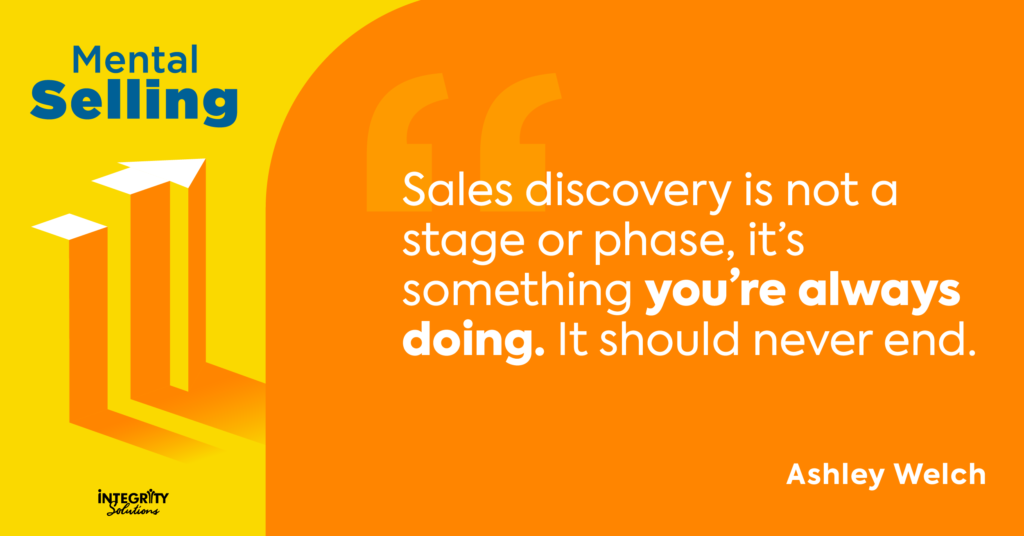

Hear our conversation as we discuss:
- Applying design thinking throughout the sales process and becoming more truly customer-centric
- Getting salespeople to be more curious and thinking about their customer’s customer
- Meeting the demands of more complex deals and expanding buying committees with a more team-based selling approach
- Storytelling and how salespeople can make stories come alive and be more relatable for customers
Join us on this latest episode of Mental Selling to learn more about leveraging design thinking throughout the sales process. Check out the full episode! Click the link above!
Harness the design thinking process in sales to increase customer-centricity
Before you can harness the power of design thinking, you need to understand what it is and how it works. According to Ashley, design thinking is a creative, problem-solving approach to the sales process. Like the Lean Six Sigma program, design thinking is being harnessed by organizations to increase effectiveness and innovation.
Design thinking can typically be broken down into five phases, each resulting in problem-solving or a new innovation.
However, unlike many problem-solving processes and programs, design thinking requires a non-negotiable focus on the end user- the customer’s customer.
Understanding your customer and their customer is critical mindset shift in defining the why behind your process. In design thinking, businesses capture customers’ wants, needs, and preferences as the inspiration for what they do.

Sparking curiosity for a focus on your customer’s customer
While customer centricity is vital in businesses utilizing design thinking, it can be difficult to shift focus from what you care about to what your end customers care about. Further, all levels of the team must be truly curious about the customer’s customer.
For sales, this curiosity is especially important but also exceptionally difficult. Without the knowledge and ability to connect with, care about, and communicate with customers, the sales team will lack enablement and ultimately lose conversions.
But, many sales teams are also closing-centric. Sales professionals are paid to make conversions and sometimes fail to focus on the customer, instead focusing on closing the sale.
So how do you achieve this shifted mindset on a sales team? Ashley offers insight gained through experience.
First and foremost, sales teams need to think long-term about cultivating a lasting relationship with clients by selling them systems that best meet their needs. The discovery process is one crucial step in doing this.

Go to your customer, walk the halls, speak to their customers, and find out what they truly need. Then, as needs change, continue to be invested in the end customer. By investing in continuous discovery and fostering genuine curiosity, you can begin to aim your organization toward customer-centricity.
Bringing stories to life for enhanced relatability
One of the most effective tools to achieve, maintain, and communicate this customer-centricity is storytelling.
The key to connecting with customers is relatability, and generic use cases aren’t gaining salespeople any personability points. The art of storytelling fosters soft skills that are necessary for human connection.
Sales are typically fast-paced and high-stakes. But the team members that sell the most often aren’t those with the most robust product knowledge or even those with the best traditional sales skills. Instead, the highest performing salespeople can connect with customers through storytelling.
Ashley offers some specific things you can do to make your stories come to life:
- Make it character-driven
- Include an emotional aspect
- Sprinkle in specific details
When a story is told and includes these three factors, it is relatable. Relatable stories make a difference in customers’ thoughts, opinions, and memories. Chances are, if you connect with a potential customer in a relatable, personal way by telling them a great story, you will stick in their memory even if they choose not to purchase.
Ultimately, design thinking allows businesses to shape customer centricity by letting go of personal wants and goals and embracing end customer needs. This approach leads to greater long-term success, even though it may decrease initial minor sales as the team stops selling products that the customer doesn’t truly need.
Design Thinking and the Sales Process Podcast Related Links
Follow Ashley on LinkedIn
Somersault Innovation website
Follow Somersault Innovation on Twitter
Raise your Mental Selling acumen with us by following us on Apple Podcasts, Spotify, Google Podcasts SoundCloud, Amazon, iHeartRadio, Stitcher or wherever you get your podcasts. Please rate our show or leave a comment— we value YOUR feedback! FeedSpot has also included us as one of the top 30 best sales podcasts to follow.

